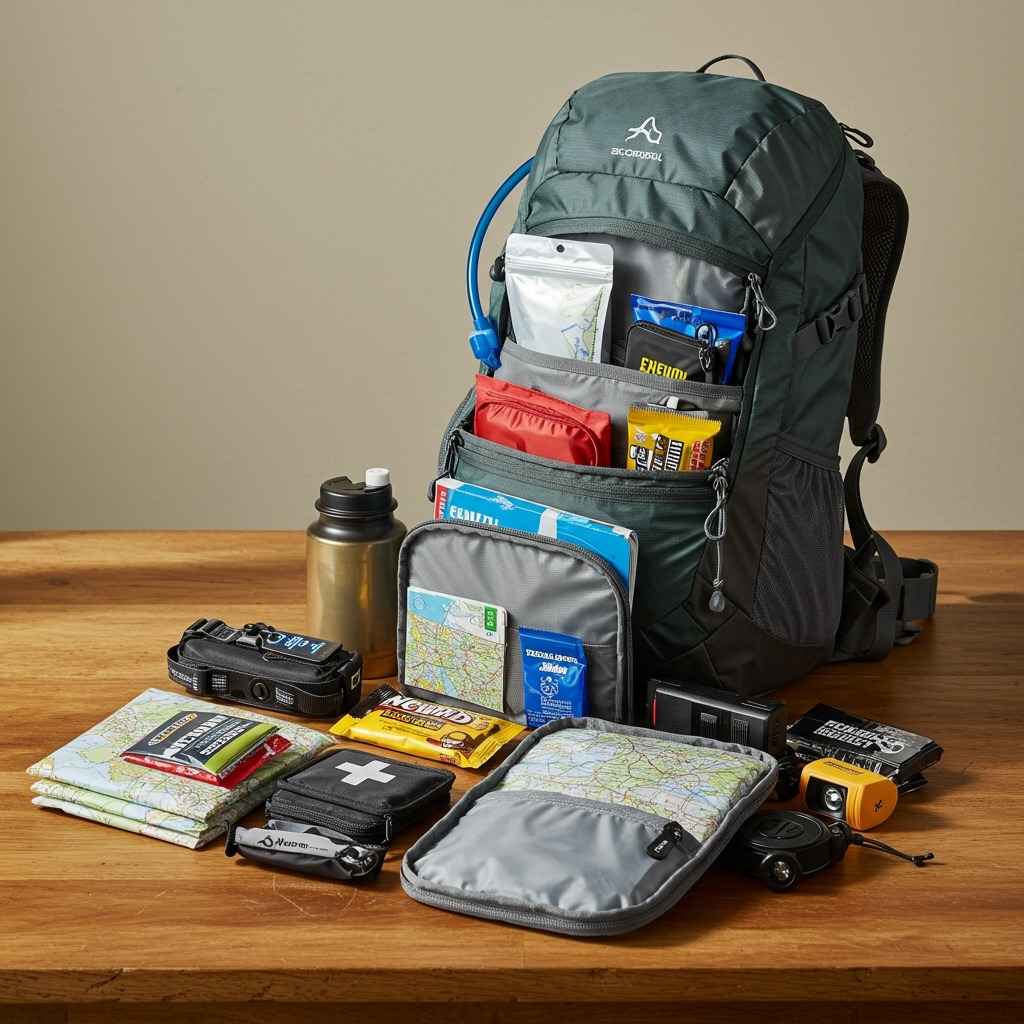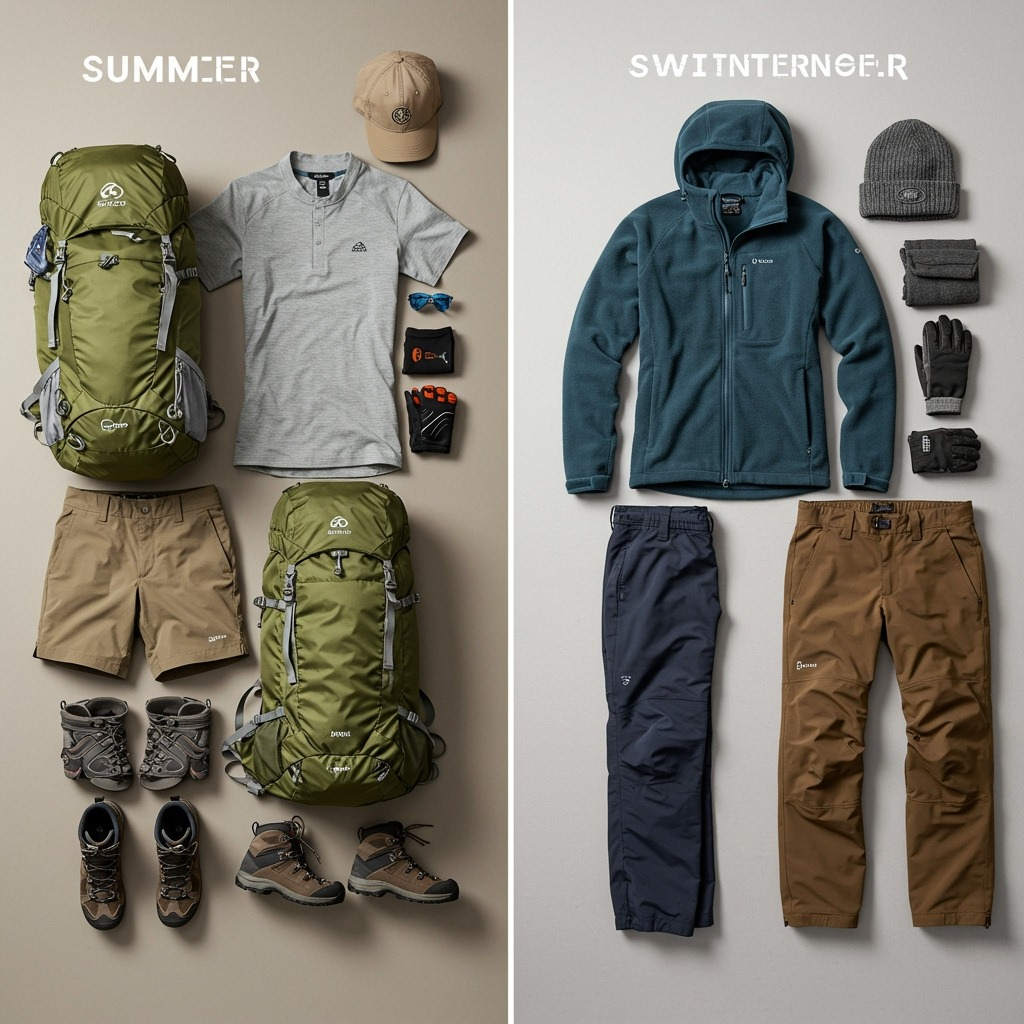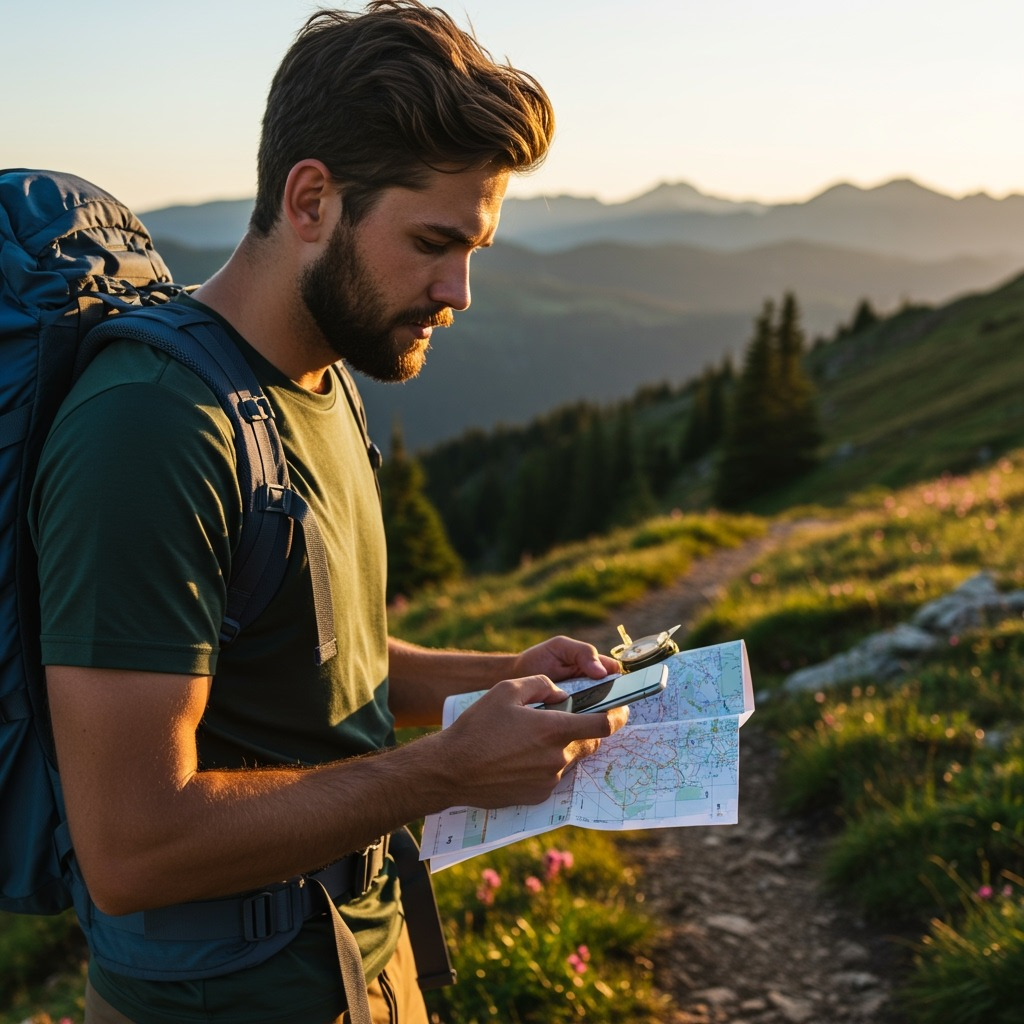Three years ago, I watched a fellow hiker turn around just two miles into what should have been an epic 10-mile trail adventure in the Rockies. She was wearing cotton jeans that had soaked through with sweat, carrying only a single water bottle for an 8-hour hike, and had no backup plan when storm clouds started rolling in. That moment reminded me of my own early hiking disasters—the times I learned the hard way that what you pack can make or break your outdoor adventure.
What to pack for hiking depends on your trail length, weather conditions, and experience level, but certain essentials should accompany every hiker regardless of the journey ahead. Whether you’re planning a quick nature walk or an all-day mountain trek, proper packing ensures safety, comfort, and the ability to handle unexpected situations that arise on the trail.
Understanding hiking preparation connects directly to broader outdoor skills and safety practices. Before heading out, make sure you understand why you need a fishing license if you’re planning to combine fishing with your hiking adventure.
The Essential Hiking Backpack: Your Mobile Base Camp
Your hiking backpack serves as your mobile base camp, carrying everything needed for a successful trail experience. A quality daypack makes the difference between a comfortable hike and a miserable slog through the wilderness with gear digging into your back and shoulders.
For most day hikes, a pack in the 20-35 liter range provides the sweet spot between adequate storage and comfortable carrying. This size accommodates extra layers, food, water, and safety essentials without feeling bulky or requiring you to cram items into insufficient space.
Key Backpack Features
When selecting a hiking backpack, prioritize these essential features:
- Adjustable torso length for proper fit across different body types
- Padded shoulder straps that distribute weight evenly
- Hip belt with pockets for frequently accessed items
- Hydration reservoir sleeve for hands-free water access
- External attachment points for trekking poles and overflow gear
- Weather-resistant fabric to protect contents from light rain
Proper fit matters more than brand names or fancy features. A well-fitted budget pack outperforms an expensive pack that doesn’t match your body dimensions. Visit a gear shop to try different options and get properly fitted before making a purchase.
Packing Strategy
Organize your pack with frequently accessed items on top or in external pockets. Heavy items should sit close to your back and between your shoulder blades for optimal weight distribution. Keep emergency items easily accessible but secure enough that they won’t fall out during active hiking.
Water represents your heaviest single item, so position it strategically. Hydration reservoirs with drinking tubes allow constant hydration without stopping to dig through your pack. For longer hikes, supplement reservoir water with backup bottles stored in side pockets.
Many successful hikers also enjoy combining their trail adventures with other outdoor activities. Our guide on how to use a fishing rod provides essential techniques for those planning fishing stops during hiking trips.

Clothing and Layering Systems: Dress for Success
Proper hiking clothing protects you from the elements while providing comfort and freedom of movement throughout your adventure. The layering system offers maximum versatility for changing conditions you’ll encounter on the trail, from cool morning starts to warm midday temperatures and potentially chilly evening finishes.
Base Layer Foundation
Start with moisture-wicking materials against your skin. Avoid cotton at all costs—when wet, cotton loses insulation properties and can contribute to hypothermia in cool conditions. Synthetic materials or merino wool provide superior moisture management and temperature regulation.
Choose long-sleeve base layers for sun protection and versatility, even in warm weather. You can always roll up sleeves when temperatures rise, but you can’t add material that isn’t there when unexpected weather arrives.
Insulation Layer Options
Your insulation layer provides warmth when temperatures drop. Lightweight fleece or synthetic insulation offers the best balance of warmth, packability, and quick-drying properties for most hiking conditions.
Down insulation provides a superior warmth-to-weight ratio but loses effectiveness when wet. Reserve down for dry conditions or ensure you have reliable weather protection when carrying down layers.
Outer Shell Protection
A waterproof, breathable rain jacket serves as your final defense against wind and precipitation. Quality rain gear keeps you dry from both external moisture and internal perspiration through advanced fabric technology that blocks rain while allowing sweat vapor to escape.
Look for jackets with full-length front zippers, adjustable hoods, and pit vents for temperature regulation. Avoid cheap rain gear that creates a sauna effect—you’ll end up as wet from trapped sweat as you would from rain.
Bottom Half Considerations
Hiking pants or shorts should prioritize durability, stretch, and quick-drying properties. Convertible pants with zip-off legs provide maximum versatility for changing temperatures and trail conditions.
Synthetic materials outperform cotton for active use, offering better moisture management and durability against trail obstacles. Many hiking pants include reinforced knees and seat areas for extended durability.
Essential Safety and Navigation Equipment
Safety equipment transforms potential emergencies into manageable inconveniences. Carrying the right safety gear provides peace of mind and practical solutions when trail conditions deteriorate or unexpected situations arise.
Navigation Essentials
Modern smartphone apps like AllTrails or Gaia GPS provide excellent navigation capabilities, but technology fails when you need it most. Download offline maps before leaving cell coverage and ensure your phone battery starts at 100%.
Backup navigation includes a paper map and compass for your hiking area. Even if you never use them, having non-electronic navigation options provides security when technology fails. Learn basic map and compass skills before relying on them in emergency situations.
A whistle weighs almost nothing but can summon help across long distances when needed. Three sharp blasts represent the universal distress signal that carries much farther than shouting.
First Aid Fundamentals
A basic first aid kit handles common trail injuries and medical needs. Customize your kit based on group size, trip length, and personal medical requirements. Basic components include:
- Adhesive bandages in various sizes
- Medical tape and gauze pads
- Antiseptic wipes for wound cleaning
- Pain relievers (ibuprofen, acetaminophen)
- Blister treatment and prevention
- Personal medications in waterproof containers
Learn basic first aid skills before heading into remote areas. A first aid kit provides no benefit if you don’t know how to use its contents effectively.
Emergency Shelter and Fire
Emergency shelter provides life-saving protection if you’re forced to spend an unexpected night outdoors. Space blankets (emergency bivouacs) weigh only ounces but can prevent hypothermia in emergency situations.
Fire-starting capability includes waterproof matches, a lighter, and fire-starting material like dry tinder or commercial fire starters. Practice fire-building skills in controlled environments before depending on them in emergencies.
A multi-tool or knife serves countless purposes from food preparation to gear repair. Choose quality over quantity—a simple, reliable tool outperforms a gadget-filled option that fails when needed.
Understanding how these safety skills connect to broader outdoor preparedness enhances your overall confidence. For those planning extended outdoor adventures, our guide on best camping snacks provides energy-dense options that pack efficiently and provide sustained nutrition.

Food, Water, and Nutrition Strategy
Proper nutrition and hydration fuel your hiking performance while providing energy reserves for unexpected situations. Strategic food and water planning prevents energy crashes and dangerous dehydration that can turn enjoyable hikes into survival situations.
Hydration Requirements
Water needs vary dramatically based on temperature, humidity, exertion level, and individual physiology. Start with one liter per hour of hiking as a baseline, then adjust based on conditions and personal experience.
Hot weather, high altitude, and strenuous terrain increase water requirements significantly. Cool conditions still require adequate hydration—thirst response diminishes in cold weather, even as your body continues losing fluids.
Electrolyte replacement becomes crucial on longer hikes when you’re sweating heavily. Sports drinks, electrolyte tablets, or natural options like salted nuts help maintain proper mineral balance.
Consider water treatment for longer hikes with natural water sources. Lightweight filters or purification tablets allow you to refill from streams and lakes, reducing the weight penalty of carrying all necessary water.
Trail-Worthy Food Selection
High-energy, non-perishable foods provide sustained energy without weighing down your pack. Ideal hiking foods combine carbohydrates for quick energy with protein and healthy fats for sustained fuel.
Excellent hiking food options include:
- Energy bars and granola bars
- Trail mix with nuts, dried fruit, and chocolate
- Jerky for protein and sodium replacement
- Fresh fruit that won’t bruise (apples, oranges)
- Nut butter packets for sustained energy
- Whole-grain sandwiches for longer hikes
Avoid foods that melt, spoil easily, or require preparation. Save the elaborate trail cooking for backpacking trips—day hiking food should be ready to eat and easy to access.
Meal Timing Strategy
Eat small amounts frequently rather than large meals. This approach maintains steady energy levels while preventing the sluggishness that accompanies large meals.
Start eating before you feel hungry and drinking before you feel thirsty. By the time your body signals these needs, you’re already behind on nutrition and hydration.
Pack extra food beyond your planned consumption. Emergency rations provide crucial calories if you’re delayed or encounter unexpected situations requiring extended time outdoors.
Seasonal and Weather-Specific Considerations
Different seasons and weather conditions require specific gear adjustments and safety considerations. Understanding seasonal variations helps you pack appropriately for the conditions you’ll actually encounter rather than perfect weather scenarios.
Summer Hiking Adaptations
Hot weather hiking prioritizes heat management and sun protection. Start early to avoid peak temperatures and choose shaded trails when possible.
Summer-specific gear includes:
- Wide-brimmed hat for face and neck protection
- Sunglasses rated for high UV exposure
- Sunscreen (SPF 30+ minimum)
- Lightweight, light-colored clothing
- Extra water and electrolyte replacement
- Insect repellent for bug-prone areas
Heat exhaustion and heat stroke pose serious risks during summer hiking. Learn the warning signs and prevention strategies before venturing out in hot conditions.
Cold Weather Preparations
Winter and shoulder season hiking requires more extensive preparation due to rapidly changing conditions and increased consequences of equipment failure.
Cold weather essentials include:
- Insulating layers (fleece, down, synthetic fill)
- Waterproof outer layers for wind and precipitation
- Warm hat and insulated gloves
- Insulated, waterproof footwear
- Hand and foot warmers for emergency use
- Emergency shelter rated for cold conditions
Hypothermia risk increases dramatically in cold, wet conditions. Pack extra insulation and understand how to recognize and treat hypothermia symptoms.
Rain and Storm Preparedness
Wet weather transforms easy trails into challenging, potentially dangerous terrain. Waterproof gear and appropriate footwear become essential for safety and comfort.
Rainy weather essentials:
- Waterproof rain jacket and pants
- Pack cover or waterproof pack liner
- Quick-dry clothing materials
- Footwear with aggressive tread patterns
- Gaiters to keep debris out of shoes
- Extra dry clothes in waterproof stuff sacks
According to the National Park Service, proper preparation for weather conditions represents one of the most important factors in hiking safety and enjoyment.
Altitude and Mountain Considerations
High altitude hiking presents unique challenges requiring specific preparation and gear modifications. Increased UV exposure, temperature extremes, and altitude effects demand careful planning.
High altitude additions:
- Enhanced sun protection (higher SPF, lip balm)
- Extra layers for temperature swings
- Increased water and food requirements
- Understanding of altitude sickness symptoms
- Emergency descent planning
For those planning mountain adventures that include multiple outdoor activities, our guide on how to stay warm while camping provides essential techniques for overnight mountain experiences.

Technology, Communication, and Emergency Planning
Modern technology enhances hiking safety and navigation, but it requires thoughtful integration with traditional skills and backup systems. Smart technology use improves your hiking experience without creating dangerous dependencies on devices that can fail.
Communication and GPS Technology
Smartphone apps provide powerful navigation capabilities when properly configured and used. Download offline maps for your hiking area and familiarize yourself with app functions before depending on them in the field.
Essential smartphone preparations:
- Download offline maps for the entire hiking area
- Carry a portable battery bank or solar charger.
- Use airplane mode to conserve battery when not actively navigating.
- Take screenshots of key map sections as additional backup.
- Inform others of your planned route and return time.
Satellite communicators like Garmin inReach devices provide two-way communication in areas without cell coverage. These devices enable emergency rescue coordination and regular check-ins with family during extended hikes.
Emergency Planning and Communication
Always inform someone of your hiking plans, including route, expected return time, and emergency contacts. Leave detailed itineraries with reliable people who will take action if you don’t return as planned.
Essential emergency information includes:
- Trailhead location and parking details
- Planned route with major landmarks
- Expected hiking pace and rest stops
- Alternative routes or bailout options
- Emergency contact information
- Vehicle description and license plate
Check weather forecasts and trail conditions before departing. Postpone or modify plans when conditions exceed your preparation level or comfort zone.
Photography and Documentation
Document your hiking adventures while respecting Leave No Trace principles and focusing on safety over perfect shots. Lightweight cameras or smartphones capture memories without significantly impacting pack weight.
Photography considerations:
- Bring extra batteries or power banks for extended shooting
- Use protective cases for electronics in wet conditions.
- Focus on experiences over equipment—enjoy the moment.
- Respect wildlife and sensitive environments.
- Share location information responsibly to prevent overcrowding

FAQ Section
How much water should I bring on a day hike?
Plan for one liter per hour of hiking as a starting point, then adjust based on temperature, humidity, your sweat rate, and trail difficulty. Hot weather, high altitude, and strenuous terrain require significantly more water. Always carry extra water beyond your calculated needs for emergencies.
What type of shoes are best for hiking?
Choose footwear based on terrain and personal preferences. Hiking boots provide maximum ankle support for rocky, uneven trails, while hiking shoes or trail runners offer more flexibility and lighter weight for well-maintained paths. Ensure proper fit and break in new footwear before long hikes.
Do I need special hiking clothes, or can I wear regular athletic wear?
Avoid cotton clothing as it retains moisture and loses insulation when wet. Synthetic materials or merino wool provide better moisture-wicking and temperature regulation. You don’t need expensive hiking-specific brands, but prioritize functional fabrics over cotton athletic wear.
What should I pack for a short 2-3-hour hike?
Essential items include water, snacks, a small first aid kit, sun protection, weather-appropriate layers, navigation tools (phone with offline maps), and a whistle. Even short hikes can become emergencies if the weather changes or injuries occur.
How do I know if I’m packing too much gear?
Your pack should feel balanced and comfortable throughout your hike. If you’re constantly adjusting straps, feeling off-balance, or experiencing pain, you may be carrying too much. Start with essentials and add items based on experience and specific trail requirements rather than packing for every possible scenario.
